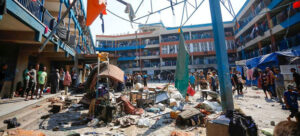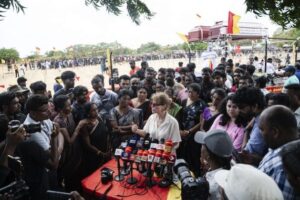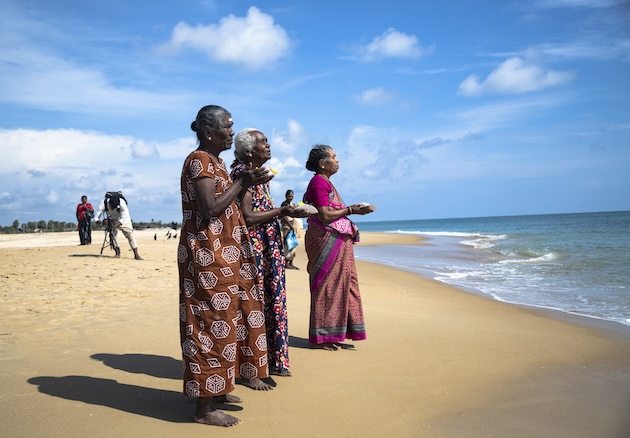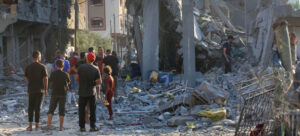
Armed Conflicts, Biodiversity, Civil Society, Climate Action, Climate Change, COP16, Editors’ Choice, Environment, Featured, Food and Agriculture, Food Security and Nutrition, Food Sustainability, Global, Headlines, Humanitarian Emergencies, Natural Resources, Sustainable Development Goals, TerraViva United Nations

Edward Mukiibi, President, Slow Food. Credit: Busani Bafana/IPS
– Edward Mukiibi, President of Slow Food, champions agroecology as a transformative answer to the world’s most pressing crises: food insecurity, climate change, and violent conflicts.
In a world where these challenges intersect, Mukiibi called for an urgent rethink of our approach to food systems.
Agroecology, a practice already embraced by millions of farmers worldwide, is emerging as a sustainable alternative to the industrialized agriculture model that dominates today. It emphasizes biodiversity, environmental stewardship, and equitable livelihoods—elements that Mukiibi insists are key to addressing the multifaceted crises facing our planet.
Speaking ahead of the highly anticipated Terra Madre 2024 event in Turin, Mukiibi called for immediate global action to end the misuse of food as a weapon in war-torn regions like Gaza and Ukraine, where food scarcity is exacerbating human suffering.
“Slow Food strongly advocates for an end to all violence in the ongoing conflicts, from the Gaza Strip to Sudan, from Lebanon to the Democratic Republic of Congo, from Ukraine to Yemen, and opposes the use of food as a weapon of war, said Mukiibi, calling for immediate negotiations to achieve a just solution that ensures the dignity of all people and fosters a peaceful future for everyone.
With global crises growing more complex, Mukiibi stresses that agroecology is not just about farming techniques—it is a framework for building more resilient societies.

Carlo Petrini, Founder, Slow Food. Credit: Busani Bafana/IPS
The Power of Agroecology
As climate change accelerates, its devastating impacts—melting glaciers, rising sea levels, extreme weather events, and shifting ecosystems—are becoming harder to ignore. Mukiibi linked these environmental crises directly to our food systems, calling industrial agriculture a “leading culprit.” He argues that agroecology offers a path toward resilience, citing its ability to regenerate soil health, reduce social inequality, and provide local communities with economic opportunities.
Mukiibi’s call for change comes as 3,000 international delegates convene at the biennial Terra Madre event to explore solutions for sustainable food systems. He argues that agroecology not only regenerates soil fertility and promotes environmental health but also strengthens local economies, reduces social inequalities, and builds resilience against climate-induced disasters.
“As climate change intensifies, agroecology offers a path to more resilient and equitable food systems,” Mukiibi declared. “This situation compels us to reflect on the transformation needed if we want to achieve a food system that feeds all people well, regenerates and protects the environment, and allows local cultures to survive and prosper.”
A Call for Global Food System Reset
Carlo Petrini, the founder of Slow Food, echoed Mukiibi’s sentiments, calling for nothing less than a complete reset of the global food system.
“The current global food system is not only unfair but is criminal because it destroys our mother earth, it destroys biodiversity and is based on waste and it has turned food into a price, not into a value,” said Petrini. “We need to restore the value of food because food represents our common good; with food we can establish relations with each other, we can establish reciprocity.”
Petrini emphasized the political significance of food in shaping our future, asserting that the fight for sustainable food systems is inherently tied to larger social and environmental battles.
Petrini also condemned multinational corporations that prioritize profit over the health of the planet, calling on them to stop polluting ecosystems through unsustainable food production methods. He called for an ecological transition.
Food and Humanity
Pope Francis, head of the Catholic Church, also weighed in, highlighting the spiritual and cultural dimensions of food.
In a message to the Terra Madre network, the Pope criticized the commodification of agriculture, noting that it is being manipulated for profit at the expense of both the environment and human dignity.
The Pope praised Terra Madre for fostering a movement that respects the integrity of both food and culture. He argued that only through recognizing the value of food and promoting food education can humanity move towards a future of universal fraternity—a future where diversity is celebrated rather than a cause of division.
The Food Revolution
Launched 20 years ago, Terra Madre has sparked a global food revolution. Over the past two decades, it has united small-scale producers, farmers, and consumers committed to creating a better, cleaner, and fairer food system.
Mukiibi said Terra Madre 2024 serves as a reflection point, a moment to assess the progress made and chart a course for the future.
Coinciding with Terra Madre, the G7 Agriculture Ministers met in Sicily, where Slow Food has urged governments to place food at the center of global political agendas. The call is clear: food must be recognized as a cornerstone of fundamental rights and environmental sustainability.
Mukiibi underscored that millions of farmers around the world are already practicing agroecology, ensuring food sovereignty, food security, and healthy diets. He emphasized the need to build on these successes by expanding the Slow Food network and empowering more farmers to take up agroecological practices.
Agroecology is a path forward for resilient local food systems, Mukiibi noted, explaining that Slow Food was building a network of Slow Food Farms to empower farmers and make them central to future sustainable food systems.
A Hopeful Vision for the Future
Mukiibi’s message is agroecology is not just a farming method—it’s a movement with the potential to tackle some of the most profound challenges of our time.
“Agroecology is the solution, not just for a more sustainable food system, but for addressing inequality, social injustice, and the global environmental crisis.”
As the world grapples with the devastating impacts of climate change, violent conflict, and food insecurity, the vision laid out by Slow Food offers a hopeful path forward—one where food is not a weapon, but a source of unity, resilience, and renewal.
IPS UN Bureau Report













